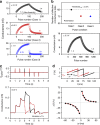Artificial optic-neural synapse for colored and color-mixed pattern recognition
- PMID: 30504804
- PMCID: PMC6269540
- DOI: 10.1038/s41467-018-07572-5
Artificial optic-neural synapse for colored and color-mixed pattern recognition
Abstract
The priority of synaptic device researches has been given to prove the device potential for the emulation of synaptic dynamics and not to functionalize further synaptic devices for more complex learning. Here, we demonstrate an optic-neural synaptic device by implementing synaptic and optical-sensing functions together on h-BN/WSe2 heterostructure. This device mimics the colored and color-mixed pattern recognition capabilities of the human vision system when arranged in an optic-neural network. Our synaptic device demonstrates a close to linear weight update trajectory while providing a large number of stable conduction states with less than 1% variation per state. The device operates with low voltage spikes of 0.3 V and consumes only 66 fJ per spike. This consequently facilitates the demonstration of accurate and energy efficient colored and color-mixed pattern recognition. The work will be an important step toward neural networks that comprise neural sensing and training functions for more complex pattern recognition.
Conflict of interest statement
The authors declare no competing interests.
Figures




References
-
- Mead C. Neuromorphic electronic systems. Proc. IEEE. 1990;78:1629–1636. doi: 10.1109/5.58356. - DOI
-
- Yu S, et al. An electronic synapse device based on metal oxide resistive switching memory for neuromorphic computation. IEEE Trans. 2011;8:2729–2737. doi: 10.1109/TED.2011.2147791. - DOI
-
- Wong HSP, et al. Phase change memory. Proc. IEEE. 2010;98:2201–2227. doi: 10.1109/JPROC.2010.2070050. - DOI
-
- Burgt Yvd, et al. A non-volatile organic electrochemical device as a low-voltage artificial synapse for neuromorphic computing. Nat. Mater. 2017;4856:1–6. - PubMed
Publication types
MeSH terms
LinkOut - more resources
Full Text Sources
Other Literature Sources

